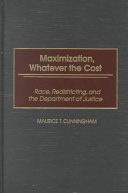

Most ebook files are in PDF format, so you can easily read them using various software such as Foxit Reader or directly on the Google Chrome browser.
Some ebook files are released by publishers in other formats such as .awz, .mobi, .epub, .fb2, etc. You may need to install specific software to read these formats on mobile/PC, such as Calibre.
Please read the tutorial at this link: https://ebookbell.com/faq
We offer FREE conversion to the popular formats you request; however, this may take some time. Therefore, right after payment, please email us, and we will try to provide the service as quickly as possible.
For some exceptional file formats or broken links (if any), please refrain from opening any disputes. Instead, email us first, and we will try to assist within a maximum of 6 hours.
EbookBell Team

4.7
16 reviewsDuring the early 1990s the Department of Justice used its Voting Rights Act power to object to racially unfair redistricting laws to force states to maximize minority congressional districts. The results were dramatic: Congressional Black Caucus membership swelled from 25 to 38 and nine new Hispanic congresspersons were sworn in. Only three years later, the maximization strategy lay in ruins. The courts forced many of the new minority districts to be redrawn and the judiciary reserved especially harsh criticism for the Department.
Cunningham examines and analyzes how the Department came to adopt the maximization strategy. He explores the bureaucratic culture of the Division's Voting Section, its history, and the interaction of its progressive career staff with more conservative political appointees. The Division works amidst a vibrant interest group environment, with civil rights advocates, the state, and political parties eager for influence. Cunningham shows how that influence contest was won by the civil rights groups, how their preferred interpretations of fair redistricting and discriminatory purpose were adopted by the Division, and how their chosen districting models were forced upon states by the Division. He examines the effect the Department has had on federalism, representation, and its own impaired credibility with the judiciary. Finally, he suggests how the Division might resurrect its damaged reputation for balanced enforcement. An important study for scholars, students, and public policy makers involved with civil rights, public administration, and public law.